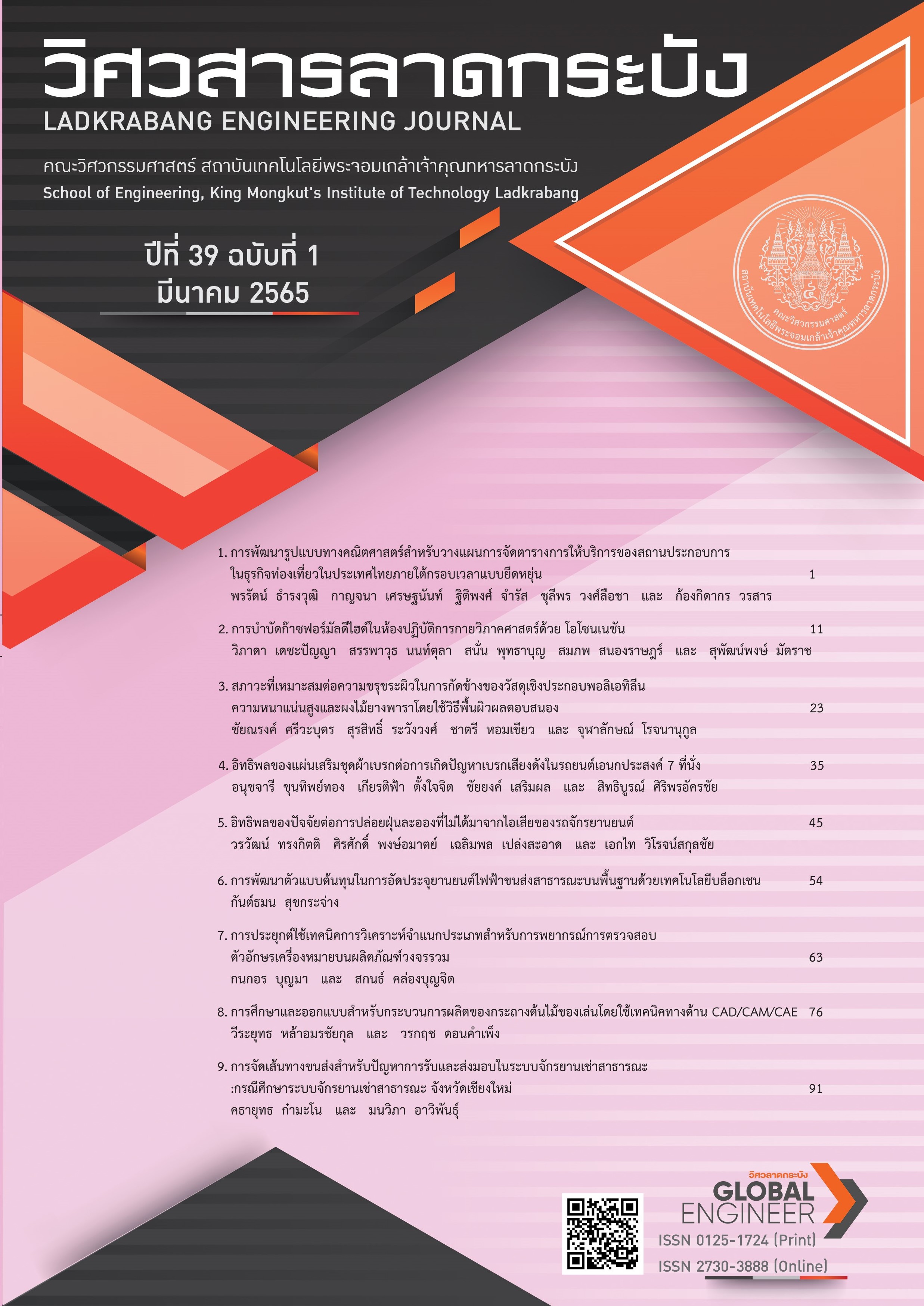Optimal Condition on Surface Roughness in Side Milling of High Density Polyethylene and Rubberwood Flour Composites using Response Surface Methodology
Keywords:
Milling, Composite Materials, Surface Roughness, Box–Behnken, Response Surface MethodologyAbstract
Surface roughness prediction in side milling of high density polyethylene and rubberwood flour composites was designed by Box-Behnken and analyzed using Response Surface Methodology. Factors in this study are speed, feed rate, and depth of cut. From the experiment, it was found that all of the factors affected on the surface roughness properties. The result of optimal condition analysis with the factors on side milling of composites found that the optimal condition was 1,000 rpm speed, 315 mm/min feed rate, and 1.0 mm depth of cut. This condition generates the surface roughness of 2.865 µm with desirability score 100%. Additionally, the real test value and the predicted response were compared to verify the accuracy of the mathematical model of the regression model. The result shows that the bias of those methods is 1.95% in which is within acceptable criteria. It was found that the optimal condition in side milling of composites obtained from the mathematical model were reliable. It is optimal for use in predicting surface roughness in composites
References
C. Srivabut, T. Ratanawilai and S. Hiziroglie, “Effect of nanoclay, talcum, and calcium carbonate as filler on properties of composites manufactured from recycled polypropylene and rubberwood fiber,” Construction and Building Materials, vol. 162, pp. 450–458, 2018, doi: 10.1016/j.conbuildmat.2017.12.048.
T. Ratanawilai and K. Taneerat, “Alternative polymeric matrices for wood-plastic composites: Effects on mechanical properties and resistance to natural weathering,” Construction and Building Materials, vol. 172, pp. 349–357, 2018, doi:10.1016/j.conbuildmat.2018.03.266.
S. Khamtree, T. Ratanawilai and S. Ratanawilai, “The effect of alkaline-silane treatment of rubberwood flour for water absorption and mechanical properties of plastic composites,” Journal of Thermoplastic Composites Material, vol. 33, no. 5, pp. 599–613, 2020, doi: 10.1177/0892705718808556.
S. Tamrakar and R. A. Lopez-Anido, “Water absorption of wood polypropylene composite sheet piles and its influence on mechanical properties,” Construction and Building Materials, vol. 25, no. 10, pp. 3977–3988, 2011, doi: 10.1016/j.conbuildmat.2011.04.031.
C. Homkhiew, T. Ratanawilai and W. Thongruang, “The optimal formulation of recycled polypropylene/rubberwood flour composites from experiments with mixture design,” Composites Part B-Engineering, vol. 56: pp. 350–357, 2014, doi: 10.1016/j.compositesb.2013.08.041.
T. Ratanawilaia, P. Pitsuwan, S. Jirasampata and C. Homkhiew, “Influence of Milling Factors on Surface Finish of Wood-Plastic Composites,” Ladkrabang Engineering Journal, vol. 32, pp. 43–48, 2015.
J. Lamaming, R. Hashim, O. Sulaiman, T. Sugimoto, M. Sato and S. Hiziroglu, “Measurement of some properties of binderless particleboards made from young and old oil palm trunks,” Measurement, vol 47, pp. 813–819, 2014, doi: 10.1016/j.measurement.2013.10.007.
S. Rimdusit, W. Smittakorn, S. Jittarom and S. Tiptipakorn, “Highly filled polypropylene rubber wood flour composites,” Engineering Journal, vol 15, no. 2, pp. 17–30, 2011, doi: 10.4186/ej.2011.15.2.17.
R. Z. Huang, B. J. Kim, S. Lee, Z. Yang and Q. L. Wu, “Co-extruded wood-plastic composites with talc-filled shells: morphology, mechanical, and thermal expansion performance,” BioResources, vol. 8, no. 2: pp. 2283–2299, 2013.
T. Ratanawilai, P. Lekanukit, S. Urapantamas, “Effect of rubberwood and palm oil content on the properties of wood–polyvinyl chloride composites,” Journal of Thermoplastic Composites Material, vol. 27, no. 6, pp. 719–730, 2014.
N. Ayrilmis, U. Buyuksari and T. Dundar, “Waste pine cones as a source of reinforcing fillers for thermoplastic composites,” Journal of Applied Polymer Science, vol. 117, no. 4, pp. 2324–2330, 2010, doi: 10.1002/app.32076.
E. O. Olakanmi, E. A. Ogunesan, E. Vunain, R. A. Lafia-Araga, M. Doyoyo and R. Meijboom, “Mechanism of Fiber/Matrix Bond and Properties of Wood Polymer Composites Produced From Alkaline-Treated Daniella oliveri Wood Flour,” Journal of Polymer Composites, vol. 37, no. 9, pp. 2657–2672, 2016, doi: 10.1002/pc.23460.
C. Homkhiew, S. Rawangwong, W. Boonchouytan and W. Thongruang, “Mechanical and physical properties of thermoplastic natural Rubber,” SWU Engineering Journal, vol. 13, no 1, 107–122, 2018.
C. Srivabut, T. Ratanawilai and S. Hiziroglie, “Response surface optimization and statistical analysis of composites made from calcium carbonate filler-added recycled polypropylene and rubberwood fiber,” Journal of Thermoplastic Composites Material, doi: 10.1177/0892705719889988.
C. Homkhiew and T. Ratanawilai, "Optimal proportions of composites from polypropylene and rubberwood flour after water immersion using experimental design," KKU Research Journal, vol. 19, no. 6, pp. 780–793, 2014.
N. Ayrilmis, S. Korkut, E. Tanritanir, J. E. Winandy and S. Hiziroglu, “Effect of various fire retardants on surface roughness of plywood,” Building and Environment, vol.41, no. 7, 887–892, 2006, doi: 10.1016/j.buildenv.2005.04.011.
C. Srivabut, T. Ratanawilai, S. Hiziroglie, “Statistical modeling and response surface optimization on natural weathering of wood-plastic composites with calcium carbonate filler,” Journal of Material Cycles and Waste Management, vol. 23, pp. 1503–1517, 2021, doi: 10.1007/S10163-021-01230-7.
C. Homkhiew, T. Ratanawilai, W. Thongruang, “Optimizing the formulation of polypropylene and rubberwood flour composites for moisture resistance by mixture design,” Journal of Reinforced Plastics and Composites, vol 33, no. 9, pp. 810–823, 2018, doi: 10.1177/0731684413518362.
Downloads
Published
How to Cite
Issue
Section
License
Copyright (c) 2022 Faculty of Engineering, King Mongkut’s Institute of Technology Ladkrabang

This work is licensed under a Creative Commons Attribution-NonCommercial-NoDerivatives 4.0 International License.
The published articles are copyrighted by the School of Engineering, King Mongkut's Institute of Technology Ladkrabang.
The statements contained in each article in this academic journal are the personal opinions of each author and are not related to King Mongkut's Institute of Technology Ladkrabang and other faculty members in the institute.
Responsibility for all elements of each article belongs to each author; If there are any mistakes, each author is solely responsible for his own articles.






